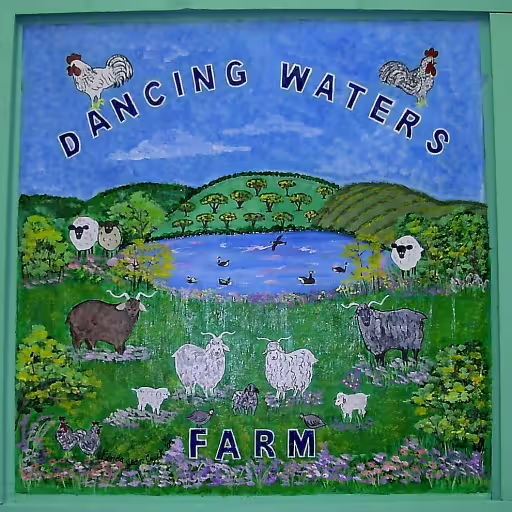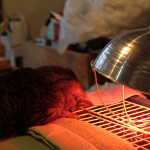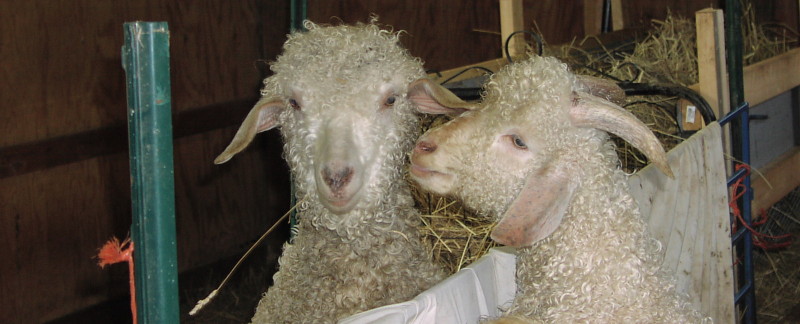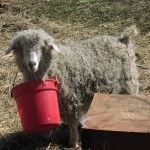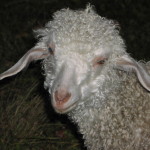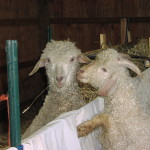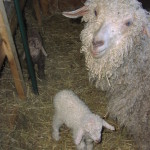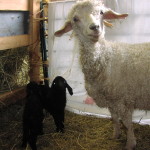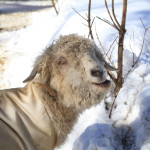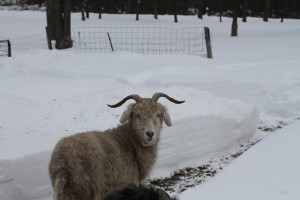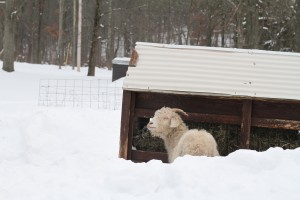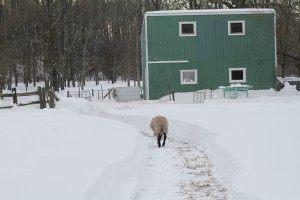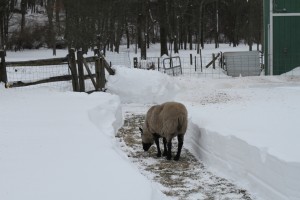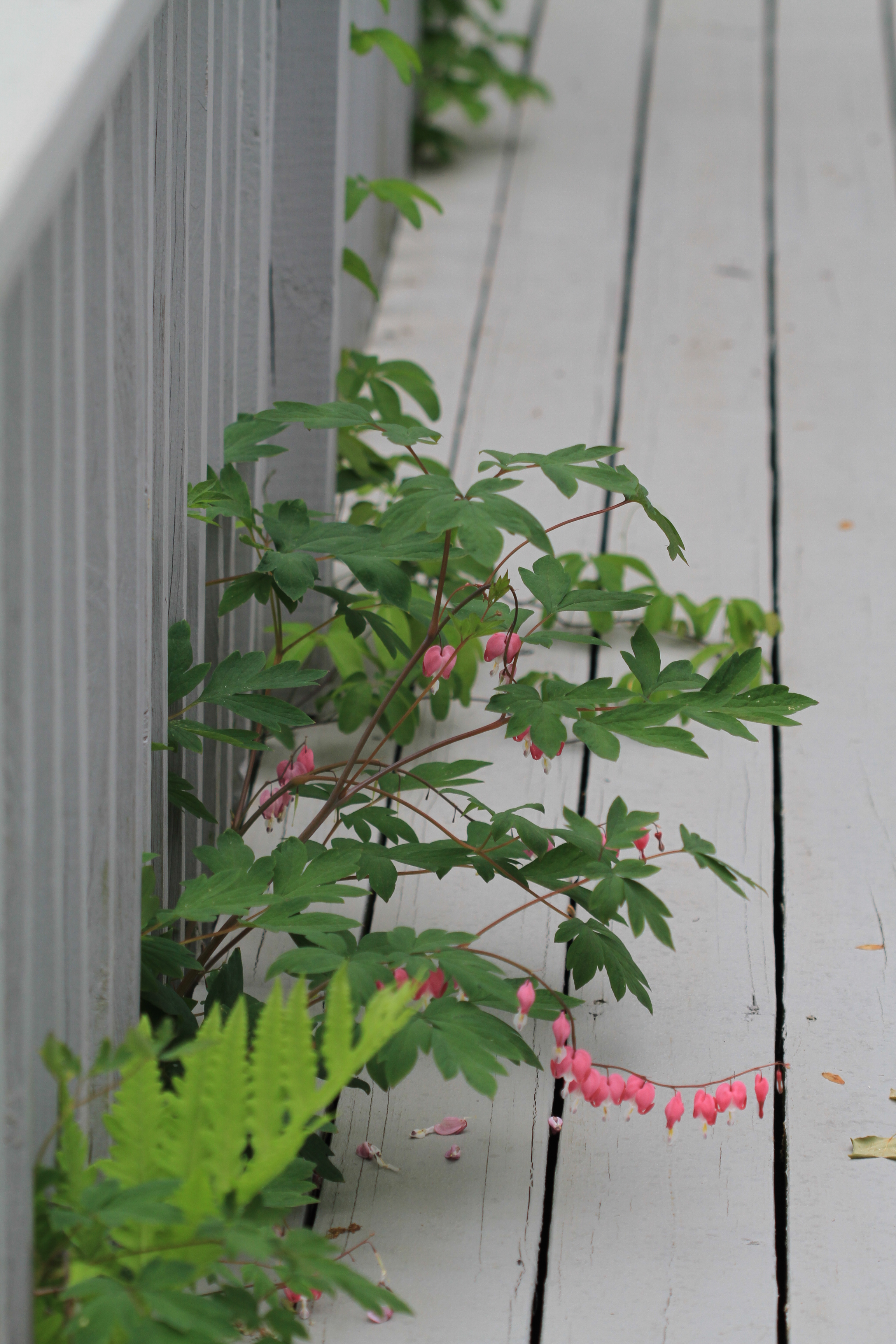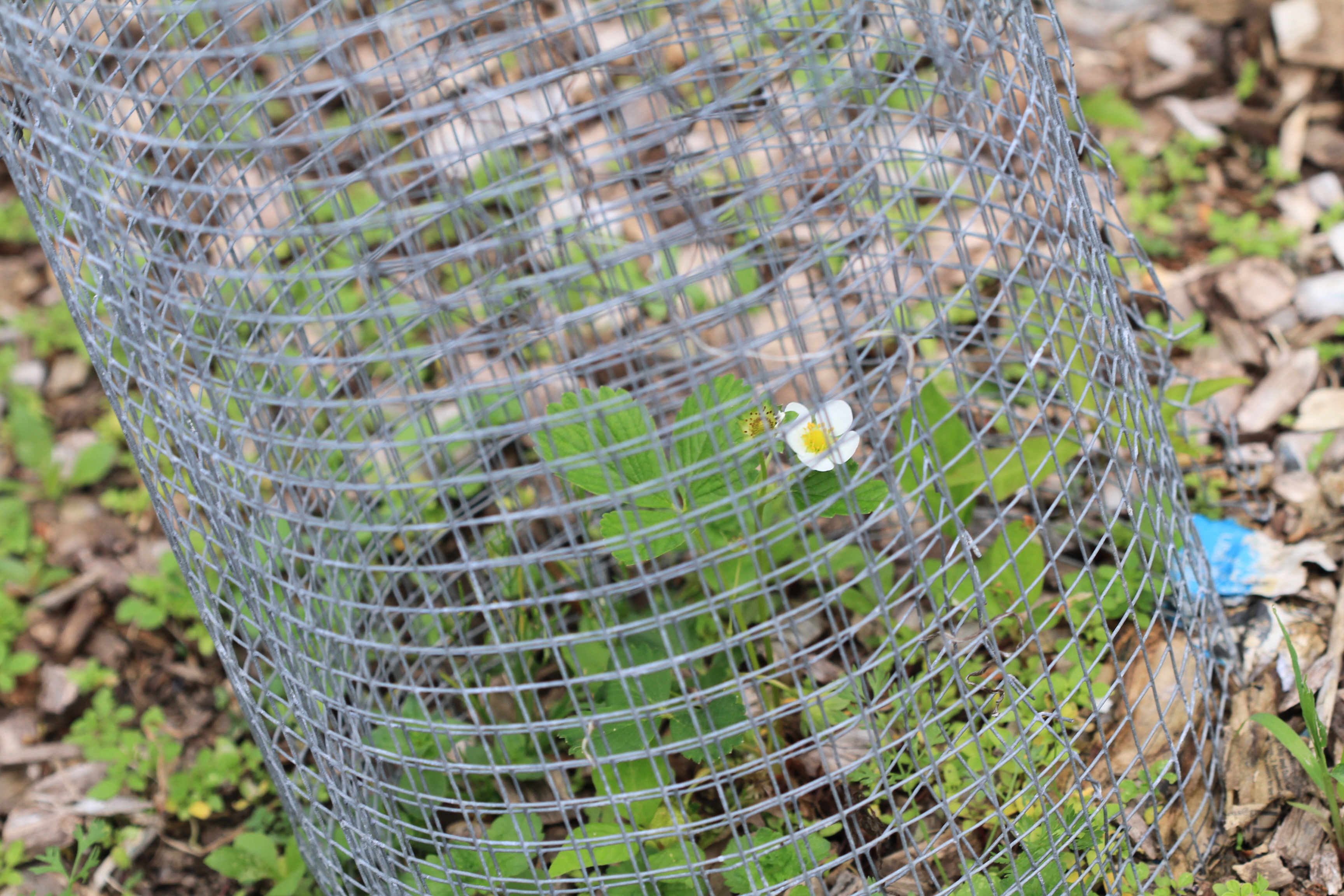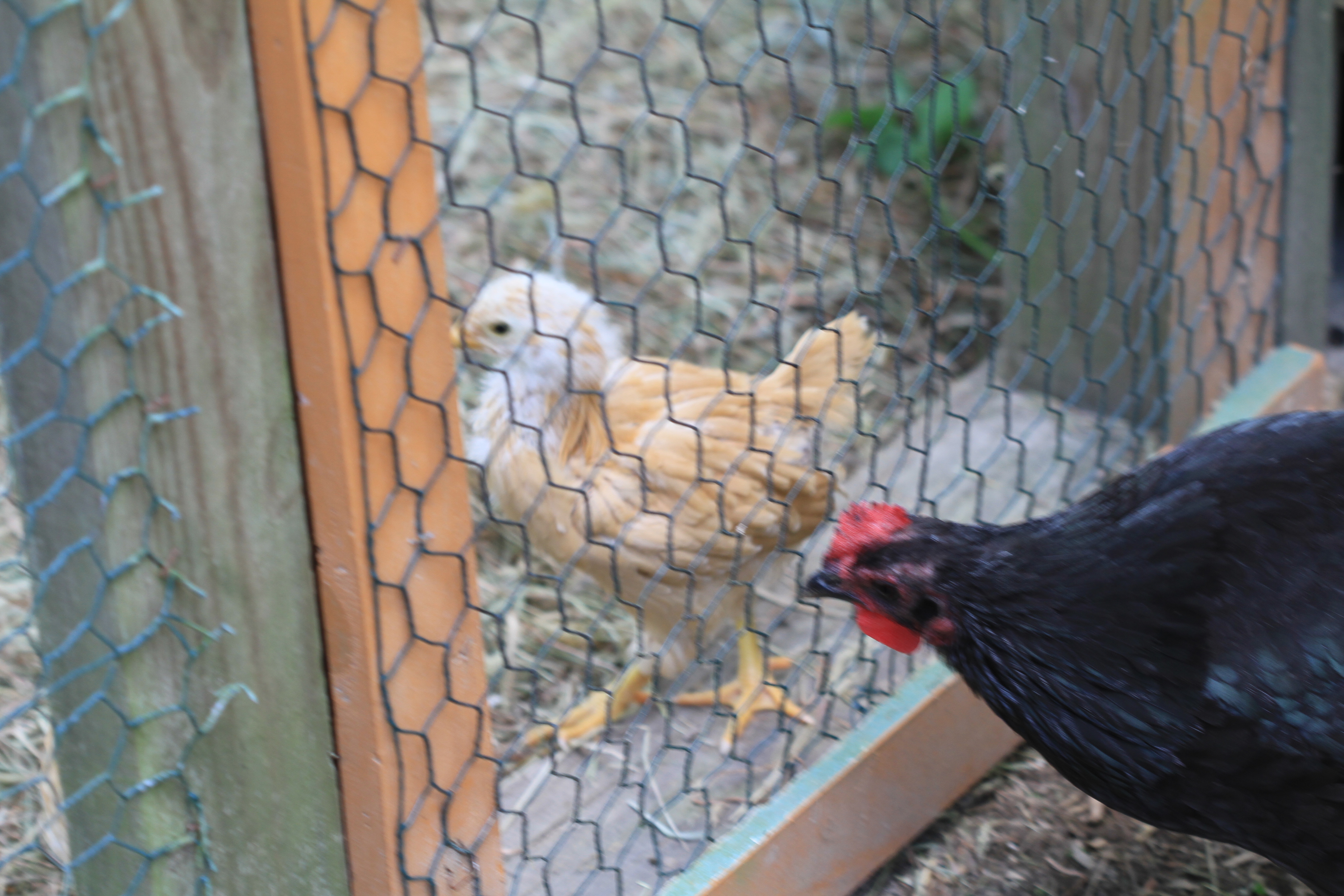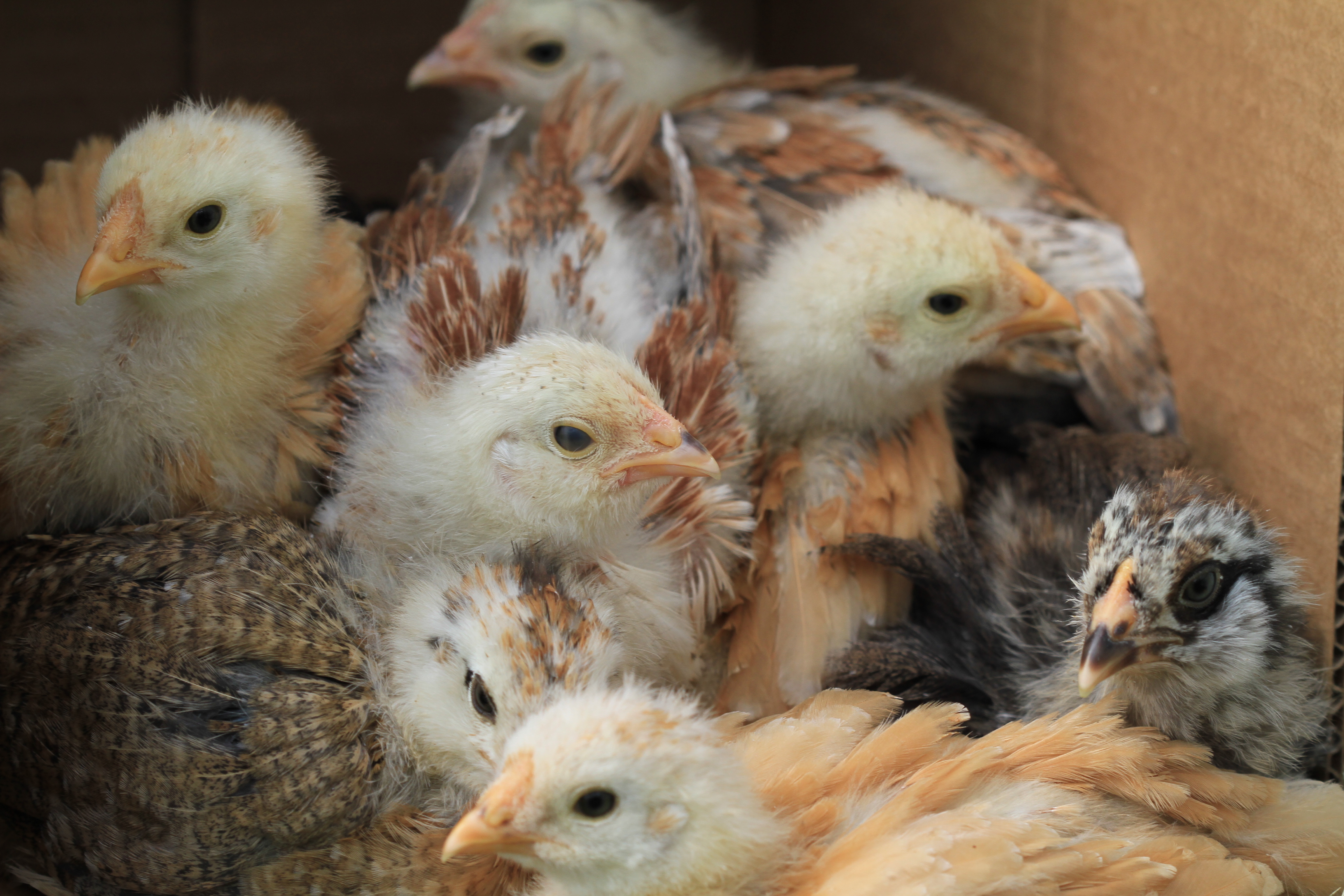It’s been a busy time for farm and wildlife activities over the last month. The weather has been quite capricious as well. I knew there would be payback for the lovely warm February this year!
Chicken Traumas….
On President’s day Regina (Salmon Favorelle hen 3 years old )
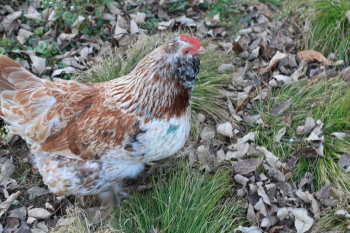
Regina – Favorelle Hen
was pecked on the head so severely by Coq Au Vin (Easter Egger rooster 1 year old)
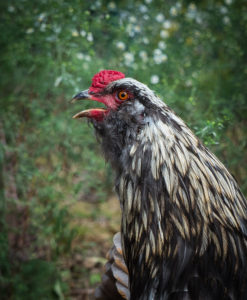
Coq Au Vin – Photo courtesy of
that the skull was visible. She made a full recovery in about 2 weeks which is yet another testament to their healing abilities and tolerance for pain (good old fashion toughness and strong will to live!).
The rooster had been picking on some of the older hens, just warning them away from his favorites, but not anything serious up to this point. My experience is that roosters that lives with a smaller group of hens will prefer them if they are then all released into a larger group. This rooster had been raised with his “sisters” until about 8 weeks when he began to be too aggressive and he was moved to a pastured area with 1 year old hens. After initial dissatisfaction (had to clip his wings to keep him in their area!), he settled in, got on with them very well and they loved him too. I’d never had a rooster attack a hen and cause such a significant wound. I put him in his own area and it was quickly clear that he’d been terrorizing some others as well because they stopped hiding within a few days. I’d thought it was hen disagreements causing the slight dissension in the main group.
Since Coq Qu Vin is very good with people I decided to re-home him thinking that starting off with a new flock he wouldn’t have any prejudices. I found a nice home for him and thought things were going well as there was no word for almost 3 weeks but alas he decided he did not like Buff Orpington hens either and he came home again. He’s in his own pen with a view of the ladies while I decide my next approach. I’m thinking of letting him run loose outside the chicken yard and roost in the greenhouse overnight.
Around the same time one of my Australorp hens broke a thigh bone completely (snapped in half) in two separate spots – one in the center of the bone, one just below the pelvis joint. No idea what happened but she was suffering greatly although she valiantly moved around using a wing to support herself on the bad leg side. She did not make it, the injury was just too severe. Most animals have appetite loss if they are in severe pain which causes them to go down, not the injury itself.
Also a Dominique hen (KFC – so named because she loves “fast food” aka corn) tore a growth off her leg which bled for a long time despite my attempts to stop the bleeding. After a week in the greenhouse with a bandage on her leg she was doing so well that I returned her to the geriatric hen pasture to complete her recovery.
Goat Issues…
The (presumably benign) tumor on James’s (12 year old Angora goat) throat finally got to a critical stage. He’s had it for over a year and I had a vet look at it soon after I first noticed it. The opinion was that it was inoperable because of the location. So…had not been looking forward to what was going to happen with him over time. The tumor had grown quite large and reached the point where his skin couldn’t stretch any more, bursting open so that he was draining fluids from the opening continually.
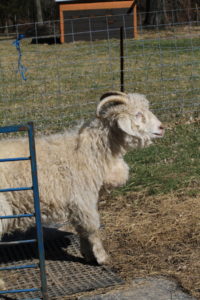
Since fly season was approaching and he was clearly not feeling good I decided to have the vet try to remove the tumor, knowing that there was a good chance he might not make it through the surgery. A big snowstorm was expected (>2″ predicted) and the vet wanted to do it the day of the storm as all his other patients had cancelled and he could focus on the difficult procedure. So… James went to the Vet the night before the storm and while my entire day was spent shoveling James surprised all of us by surviving the surgery in great shape.
He spent 5 days in the garage at night and in a stall in the barn during the days so he could be easily monitored in a sheltered, more sterile area. He has progressed nicely and is happily re-united with his brother out in his regular pasture. I still have to borrow the staple remover from the vet and take all the staples out but hope to do this early next week. His voice is normal again but he’s still coughing and choking more than normal. Hopefully that will slowly improve as all the muscles in his neck and throat heal.
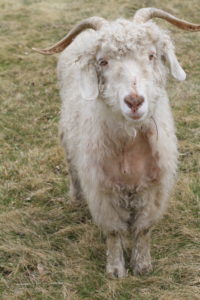
Of course he had to give me a good scare the other night. I went out to do the evening feeding and couldn’t find him. Finally I see him on the ground at the far end of a remote pasture. I call to him and there is not motion so I start running and I can’t tell he’s alive until I touch him. Then he shifts his eyes to look at me pleadingly but patiently. He had managed to get tangled up in the electric net fence intended to keep the boys from knocking heads with the girls through the main fence. There was no electricity involved, it was just being used as a visual and soft physical barrier. He was perfectly fine after I got all the wires off his horns and front legs although he was grinding his teeth (normally a sign of pain) and for a bit I thought the plastic wires had sawed into his skull at the base of the horns. Thankfully the wires were only caught on an imperfection on his horn. Needless to say this means they won’t be using that pasture again until I can work out a better barrier. Unfortunate as it has better grass than their “home” pasture and they had been using that pasture with that fencing for months now without issue!
Bunny Mishaps….
At the end of March a baby bunny (eyes still closed) was found on the main path into the chicken yard with one eye pecked partially open and a large wound on it’s back. Since the bunny was very cold it was brought into the house to be re-warmed. There was no sight of a nest even after repeated attempts to locate one so the bunny stayed in the house while I put a game camera up over night to locate the nest.
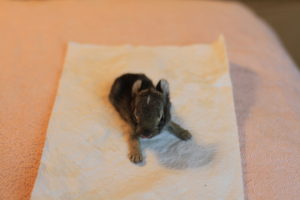
I was able to use the game camera pictures to find the bunny nest after a few tries. There were two more rabbits in the nest also with pretty full coats and eyes closed, ears down (thus <a week old). They were in the compost pile which was pretty wet due to the recent rain and full of goat poop and smelly hay as this is where the mess from the barn ends up. I imagine this was the only place the mother could dig since the ground was snow covered from the 14 inch snow we received the week prior and the lack of any real warmup to significantly melt the snow since then. It has been the second incidence of a 60 degree day followed by a significant snowfall this year.
It was safe in that it was a fenced area with electric lines around it but not safe for baby bunnies wriggling out of their nest and attracting chickens looking for snacks. The short version of events is that after several attempts to reinforce and better water proof the nest, the mother wasn’t able to find them (even though it was in the spot she had put them in) and the injured one as well as another kept escaping from the nest and striking out for parts unknown. Since they were escaping through the fence around the compost pile there was no way to ensure their safety during the day (chickens) nor a way to keep them safe from Mother Nature at night in between feedings by their mother IF she could find them.
Unfortunately rabbits are very difficult for people to raise. They require a formula that is very high in fat and protein (not even goat’s milk at 43% fat is sufficient, cow’s whole milk is 5%) plus the killer issue is they must eat a bit of their mother’s night time poop preferably every day. Yes, there are 2 kinds of rabbit poop – dry pellets and a smelly, gooey kind they do at night. Fresh poop is needed in order to inoculate their intestines with the proper bacteria to digest the fiber in greens (grass, etc.). Without rabbit poop in their diet they will quickly die once they start eating greens. So if you don’t own a rabbit or know someone nearby with a healthy domestic rabbit and are not willing to spend $60 for the proper formula, orphaned baby rabbits are history. I had been keeping the injured bunny going on goat’s milk since that was the highest fat and protein milk I could easily find and had been hoping to get the orphan back into it’s nest ASAP. Keeping the bunny warm and avoiding dehydration were my main goals.
Once I decided I couldn’t keep any of them in their nest, I started looking for a wildlife rehabilitator that handles rabbits. The NJ Association of Wildlife Rehabilitators provides a list of NJ state licensed rehabilitators on their website. Luckily Woodlands Wildlife Refuge is located fairly close to the farm and they rehabilitate rabbits. I talked to them and they agreed the situation here at the farm could not be remedied so I dropped the bunnies off for them to raise. The bunnies opened their eyes the evening before I dropped them off and they weighed 1.8 (the injured one) to 2.1 ounces! Their eyes typically open at about 7 days. The injured bunny had healed very well and the injured eye completely opened a day before the other eye. It might end being blind in the eye that got pecked, too early to tell but it looked clean and healthy at the time I dropped the bunnies off at the rehabilitators.
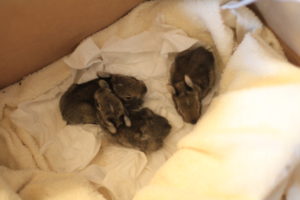
If you are interested in knowing more about raising orphaned rabbits and general information on their unique needs and growth benchmarks there is an excellent website created by Ron Hines (a vet) who covers health topics on both domestic pets and common wildlife rescue info. The injured bunny really touched my heart because it had such a strong will to live and was able to accommodate all the changes in it’s short life: learning to drink from a syringe and have it’s butt rubbed with a q tip (to encourage it to go) vs the way mom did it, a strange place with strange smells/ sounds and all while blind and in pain. Maybe the bunny thought mom had made a very poor choice of nest location and was determined to improve it’s life even at 4 days of age!
Duck Sightings on the Pond…
A pair of Buffleheads had been on the pond for months, with an occasional extra male visiting from time to time. When I went to clean out the pond overflow drain the male did a fly by quite near me several times making me think they might be nesting nearby. They are cavity nesters using old Flicker or Red Bellied Woodpecker nests of which there are lots to choose from in the trees on the east side of the pond. However, they disappeared shortly after that and haven’t been seen since Feb.
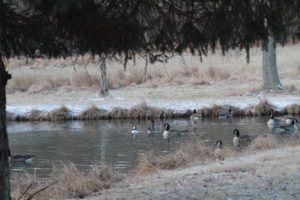
More recently a group of Ring Tailed ducks were out diving on the pond. Their is also a pair of Mallard’s that have been here all winter. The female has a bum leg which may be why they haven’t moved on.
Other (Human) Craziness…
When I bought the farm in 1997 there was a large dish antenna located near the side of the house. I managed to remove the dish and find someone who wanted it not too long often moving in but after numerous attempts to use the metal support pole for “something” I realized it had to go. Another example of how much things have changed in 20 years!
Last year I started digging around the concrete footings to scope the extent of the project. Needless to say I ran out of time as I was trying to put up a new fence around the vegetable garden and that had to take priority. Since the weather in Feb, was so lovely, I returned to the task. After I got down to over three feet, it finally dawned on me that even if I could get it completely uncovered there is no way I would be able to get it out of the hole and moved somewhere, not to mention where/how to get rid of it. I tried whacking the concrete with a sledge hammer for awhile and concluded this approach would work but I’d be nearly 80 years old before I’d finished. On to the next plan.
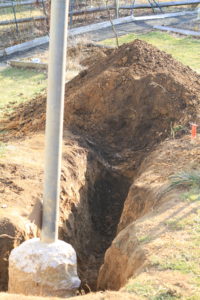
I decided to dig a trench, push it over horizontally and then cover it with dirt. Being buried under three foot of dirt would get it out of the way and wouldn’t get in the way of planting things over it. This plan also hit a snag as it turned out that there were two reinforcing rods that extended well past the bottom of the concrete foundation! After several attempts at pushing the concrete and pole over it had bent the metal rods enough that I could hacksaw through them. Success at last as the foundation and pole slowly bent over and into it’s trench grave! It only took about 45 hours of hand shoveling and 30 minutes sawing to see this amazing sight! The trench has been refilled, three blueberry bushes are planted on top and one end has sprouted grass. Definitely a project only a crazy person would have done themselves by hand!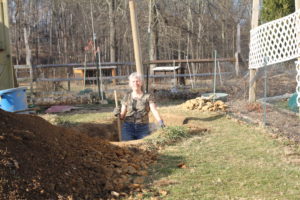
On to snowblower and lawn tractor repairs!
